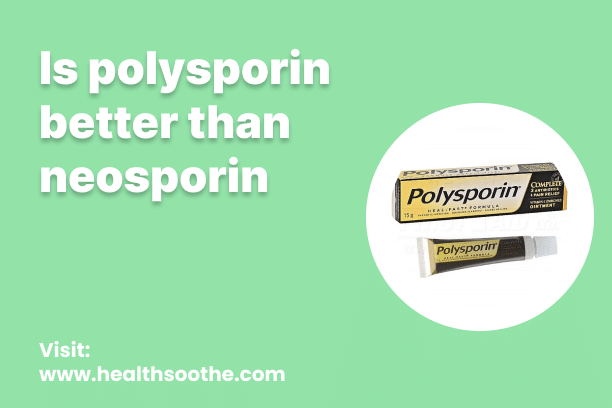Neosporin is a compound medication comprising neomycin, bacitracin, and polymyxin, antibiotics designed to halt bacterial growth. Its effectiveness is limited to bacterial skin infections, excluding those caused by fungi or viruses.
Primarily, this medication serves to prevent and address minor skin infections resulting from small cuts, scrapes, or burns. It can be obtained over-the-counter for self-administration.
What is Polysporin?
Polysporin is a combined medication employed in the treatment of skin infections. Comprising Polymyxin and bacitracin, it is effective against various infections, including infected wounds, burns, skin grafts, boils, and acne. Additionally, it can prevent catheter-related infections in individuals undergoing hemodialysis. The mechanism of action involves the eradication of bacteria responsible for these infections.
How should I use Polysporin?
Apply the Polysporin ointment to the affected area 1 to 3 times daily as instructed. Follow your doctor's guidance regarding whether to cover the area with a dressing or leave it exposed. Avoid using the ointment in the eyes. Various factors, including body weight, other medical conditions, and concurrent medications, can influence the required dosage. If your doctor prescribes a different dosage from those mentioned here, refrain from altering your medication regimen without consulting your doctor.
How should I use Neosporin?
Neosporin is intended solely for skin application. Adhere to all instructions provided on the product packaging or as directed by your physician. Should you have any inquiries, consult your doctor or pharmacist.
Begin by cleansing and drying the affected skin area. If using the ointment, wash your hands beforehand. Apply a small quantity of the medication (no more than what can fit on your fingertip) in a thin layer onto the skin, gently massaging it in, typically 1 to 3 times daily. Remember to wash your hands after applying the ointment. For the spray, ensure to shake the container well prior to use, then spray a small amount onto the affected area as instructed, generally 1 to 3 times a day. For small treatment areas, sterile bandages may be used.
Avoid excessive application or prolonged use of this medication beyond the directed duration. Overuse will not expedite healing but may elevate the risk of side effects. Refrain from using this product for over 1 week unless otherwise instructed by your doctor. Do not apply this medication to irritated skin in a child's diaper area unless directed by a physician. After application in the diaper area, avoid using tight-fitting diapers or plastic pants.
Take care to prevent contact with the eyes, nose, or mouth. In case of accidental contact, wipe off the medication and rinse thoroughly with water.
Read Also: 5 Routine Health Screenings For Every Woman In Their 40s
Can I Put Neosporin On My Private Area As A Woman?
Neosporin is not recommended for use in the genital area due to the potential for allergic reactions and disruption of the vaginal microflora, particularly in women. The vaginal flora is primarily composed of lactobacillus species, which play a crucial role in maintaining vaginal health by producing lactic acid and hydrogen peroxide, among other substances, that inhibit the growth of harmful organisms like yeast.
The presence of antibiotics in medications like Neosporin can lead to rapid changes in the vaginal microbiome, causing a decrease in lactobacilli. This disruption not only poses discomfort but also increases susceptibility to conditions such as HIV and other sexually transmitted infections.
However, women can apply Neosporin ointments to minor cuts in the outer areas around the vulva and labia, as long as it's used with caution and under appropriate circumstances.
Pros and Cons of neosporin vs polysporin
Neosporin:
Pros:
- Contains Neomycin
- Additional Ingredients
- Widely Available
Cons:
- Potential for Allergic Reactions
- Not for All Areas
- Overuse Concerns
Polysporin:
Pros:
- Contains Bacitracin and Polymyxin B
- Less Risk of Allergic Reactions
- Effective for Minor Wounds and Infections
Cons:
- Limited Availability
- Fewer Ingredients
- Potential for Resistance
Differences Between neosporin vs polysporin and sulindac
Neosporin:
Neosporin contains neomycin, bacitracin, and polymyxin B, which are antibiotics effective against a wide range of bacteria.
Polysporin:
Polysporin contains bacitracin and polymyxin B, providing broad-spectrum coverage against bacterial infections.
Sulindac:
Unlike Neosporin and Polysporin, sulindac is typically available by prescription and is not used topically but rather taken orally in the form of tablets or capsules.
Can I Put Neosporin On My Private Area As a Man?
Applying Neosporin to the male genital area without medical supervision may lead to undesirable effects. Treatment for issues and conditions in this area depends on the underlying cause, and it's essential to consult a doctor for proper diagnosis and treatment.
In some cases, a doctor may prescribe a specific cream to alleviate symptoms and address the underlying condition. Certain skin infections or wounds in the male genital area may heal on their own if the affected area is kept clean and dry. However, it's crucial to seek medical advice for appropriate management and care.
What is the difference between Polysporin and Neosporin?
The primary contrast between Polysporin and Neosporin lies in the inclusion of an additional ingredient, neomycin, in Neosporin. Neomycin is primarily utilized topically for treating superficial infections, encompassing infections from staphylococci and gram-negative bacilli, either alone or in combination.
Moreover, there exists a discrepancy in the quantities of bacitracin and polymyxin, two common constituents in both ointments. Neosporin comprises 400 units of Bacitracin, whereas Polysporin contains 500 units of the same active ingredient. Furthermore, Polysporin contains 10,000 units of Polymyxin B Sulfate, whereas Neosporin contains only 5,000 units.
Polysporin vs Neosporin: which is better for me?
While Neosporin is often preferred over Polysporin Original due to the presence of neomycin sulfate, which has demonstrated efficacy as a bactericidal agent, particularly for ocular use and against both gram-positive and gram-negative bacteria, including Staphylococcus aureus, it's important to note that Polysporin Complete offers advantages over Neosporin due to its additional ingredients.
Neomycin's effectiveness against Proteus vulgaris surpasses that of polymyxin, and its inclusion in Neosporin is complemented by moisturizing and skin-healing oils found in its formulation.
However, it's noteworthy that Polysporin Complete surpasses Neosporin due to its broader array of ingredients. The comprehensive composition of Polysporin Complete enhances its effectiveness, making it a superior choice in certain cases.
Conclusion
While Neosporin and similar over-the-counter medications can be effective for treating minor skin infections and wounds in certain areas of the body, including the outer regions around the genital area in women, they are not recommended for use in the genital area without medical supervision, especially in men. The delicate balance of the genital microflora and the potential for allergic reactions make it essential to seek professional guidance when addressing issues in this sensitive region.
Understanding the underlying cause of any genital discomfort or skin condition is crucial for proper treatment and management. Consulting a healthcare provider ensures that appropriate measures are taken to promote healing and prevent complications. Remember, maintaining good hygiene and seeking medical advice when needed are key components of genital health and overall well-being.



